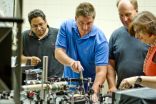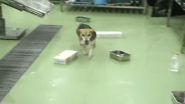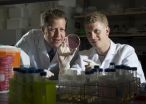Building the electron superhighway
Vermont scientists invent new approach in quest for organic solar panels and flexible electronics
2015-09-14
(Press-News.org) TV screens that roll up. Roofing tiles that double as solar panels. Sun-powered cell phone chargers woven into the fabric of backpacks. A new generation of organic semiconductors may allow these kinds of flexible electronics to be manufactured at low cost, says University of Vermont physicist and materials scientist Madalina Furis.
But the basic science of how to get electrons to move quickly and easily in these organic materials remains murky.
To help, Furis and a team of UVM materials scientists have invented a new way to create what they are calling "an electron superhighway" in one of these materials -- a low-cost blue dye called phthalocyanine -- that promises to allow electrons to flow faster and farther in organic semiconductors.
Their discovery, reported Sept. 14 in the journal Nature Communications, will aid in the hunt for alternatives to traditional silicon-based electronics.
HILLS AND POTHOLES
Many of these types of flexible electronic devices will rely on thin films of organic materials that catch sunlight and convert the light into electric current using excited states in the material called "excitons." Roughly speaking, an exciton is a displaced electron bound together with the hole it left behind. Increasing the distance these excitons can diffuse -- before they reach a juncture where they're broken apart to produce electrical current -- is essential to improving the efficiency of organic semiconductors.
Using a new imaging technique, the UVM team was able to observe nanoscale defects and boundaries in the crystal grains in the thin films of phthalocyanine -- roadblocks in the electron highway. "We have discovered that we have hills that electrons have to go over and potholes that they need to avoid," Furis explains.
To find these defects, the UVM team -- with support from the National Science Foundation -- built a scanning laser microscope, "as big as a table" Furis says. The instrument combines a specialized form of linearly polarized light and photoluminescence to optically probe the molecular structure of the phthalocyanine crystals.
"Marrying these two techniques together is new; it's never been reported anywhere," says Lane Manning '08 a doctoral student in Furis' lab and co-author on the new study.
The new technique allows the scientists a deeper understanding of how the arrangement of molecules and the boundaries in the crystals influence the movement of excitons. It's these boundaries that form a "barrier for exciton diffusion," the team writes.
And then, with this enhanced view, "this energy barrier can be entirely eliminated," the team writes. The trick: very carefully controlling how the thin films are deposited. Using a novel "pen-writing" technique with a hollow capillary, the team worked in the lab of UVM physics and materials science professor Randy Headrick to successfully form films with jumbo-sized crystal grains and "small angle boundaries." Think of these as easy-on ramps onto a highway -- instead of an awkward stop sign at the top of a hill -- that allow excitons to move far and fast.
BETTER SOLAR CELLS
Though the Nature Communications study focused on just one organic material, phthalocyanine, the new research provides a powerful way to explore many other types of organic materials, too -- with particular promise for improved solar cells. A recent U.S. Department of Energy report identified one of the fundamental bottlenecks to improved solar power technologies as "determining the mechanisms by which the absorbed energy (exciton) migrates through the system prior to splitting into charges that are converted to electricity."
The new UVM study -- led by two of Furis' students, Zhenwen Pan G'12, and Naveen Rawat G'15 -- opens a window to view how increasing "long-range order" in the organic semiconductor films is a key mechanism that allows excitons to migrate farther. "The molecules are stacked like dishes in a dish rack," Furis explains, "these stacked molecules -- this dish rack -- is the electron superhighway."
Though excitons are neutrally charged -- and can't be pushed by voltage like the electrons flowing in a light bulb -- they can, in a sense, bounce from one of these tightly stacked molecules to the next. This allows organic thin films to carry energy along this molecular highway with relative ease, though no net electrical charge is transported.
"One of today's big challenges is how to make better photovoltaics and solar technologies," says Furis, who directs UVM's program in materials science, "and to do that we need a deeper understanding of exciton diffusion. That's what this research is about."
INFORMATION:
[Attachments] See images for this press release:

ELSE PRESS RELEASES FROM THIS DATE:
2015-09-14
Free - or very inexpensive - online courses have become quite a trend in education. Massive Open Online Course (MOOC) providers currently offer thousands of courses and have enticed millions of students to enroll. The emphasis in MOOCs is often on lecture videos that students watch and learn from.
However, a study published in the Proceedings of the Second (2015) ACM Conference on Learning @ Scale shows that this central approach of MOOCs - having students watch to learn - is ineffective. Instead, the emphasis on interactive activities as advocated by Carnegie Mellon ...
2015-09-14
KINGSTON - New research out of Queen's University has found evidence of emotional load sharing between partners in a close relationship. The study, co-authored by PhD candidate Jessica Lougheed, found that a strong relationship with a loved one can help ease stress when placed in difficult situations.
"We wanted to test a new evolutionary theory in psychology called Social Baseline Theory which suggests that humans adapted to be close to other humans," says Ms. Lougheed. "The idea is that individuals function at a relative deficit when they are farther away from people ...
2015-09-14
This news release is available in Spanish.
The plants on the highest mountain in Ecuador have migrated more than 500 meters to higher altitudes during the last two centuries. This is determined in a new study, in which Aarhus University researchers compared Humboldt's data from 1802 with current conditions.
Although most of the world's species diversity is found in tropical areas, there are very few studies that have examined whether tropical mountain species are affected by climate change to the same extent as temperate species. A new study has now determined ...
2015-09-14
A recently identified molecule produced by skeletal muscle in response to exercise, has been shown to increase bone mass, according to a collaborative study between researchers at the Mount Sinai Bone Program, Icahn School of Medicine at Mount Sinai, the Department of Experimental and Clinical Medicine at University of Ancona in Italy, and the Department of Basic Medical Science, Neuroscience and Sense Organs at the University of Bari in Italy, and published online today in the Proceedings of the National Academy of Sciences (PNAS).
Although exercise is a well known ...
2015-09-14
People with congenital stationary night blindness, or CSNB, have normal vision during the day but find it difficult or impossible to distinguish objects in low light. This rare condition is present from birth and can seriously impact quality of life, especially in locations and conditions where artificial illumination is not available.
Working in collaboration with Japanese scientists, researchers at the University of Pennsylvania have for the first time found a form of CSNB in dogs. Their discovery and subsequent hunt for the genetic mutation responsible may one day ...
2015-09-14
A new study from the Gladstone Institutes shows for the first time that impairments in mitochondria--the brain's cellular power plants--can deplete cellular energy levels and cause neuronal dysfunction in a model of neurodegenerative disease.
A link between mitochondria, energy failure, and neurodegeneration has long been hypothesized. However, no previous studies were able to comprehensively investigate the connection because sufficiently sensitive tests, or assays, were not available to measure ATP (the energy unit of the cell that is generated by mitochondria) in individual ...
2015-09-14
WASHINGTON (Sept. 14, 2015) -- According to initial results of a multi-site landmark study, led by Dominic Raj, M.D., at the George Washington University (GW) site, cardiovascular disease morbidity is significantly reduced through intensive management of high blood pressure.
By targeting a blood pressure of 120 millimeters of mercury (mm Hg), lower than current guidelines, researchers found that adults 50 years and older also significantly reduced their rates of cardiovascular disease and cardiovascular events, such as heart attack and heart failure, as well as stroke, ...
2015-09-14
Humans are extremely choosy when it comes to mating, only settling down and having kids after a long screening process involving nervous flirtations, set-ups by friends, online matchmaking sites, awkward dates, humiliating rejections, hasty retreats and the occasional lucky strike. In the end, we "fall in love" and "live happily ever after." But evolution is an unforgiving force - isn't this choosiness rather a costly waste of time and energy when we should just be "going forth and multiplying?" What, if anything, is the evolutionary point of it all? A new study may have ...
2015-09-14
MRSA is bad news. If you've never heard of it, here's what you need to know: It's pronounced MER-suh, it's a nasty bacterial infection and it can cause serious disease and death.
Senior molecular biology major Jacob Hatch knows MRSA as the infection that took his dad's leg.
Hatch was thousands of miles away on an LDS (Mormon) mission when Methicillin-Resistant Staphylococcus aureus decalcified the bones in his dad's foot and lower leg, leading to an emergency amputation just below the knee.
"It was really hard to hear the news--you never expect to hear someone in ...
2015-09-14
Irvine, Calif., Sept. 14, 2015 -- University of California, Irvine researchers with the School of Medicine have identified the mechanism by which valproic acid controls epileptic seizures, and by doing so, also revealed an underlying factor of seizures.
Valproic acid is widely used to treat various types of seizure disorders, but to this point, the cellular mechanism affected by its anticonvulsant properties were not well understood.
Dr. Naoto Hoshi, an associate professor of pharmacology and physiology & biophysics, and colleagues discovered that valproic acid preserved ...
LAST 30 PRESS RELEASES:
[Press-News.org] Building the electron superhighway
Vermont scientists invent new approach in quest for organic solar panels and flexible electronics



